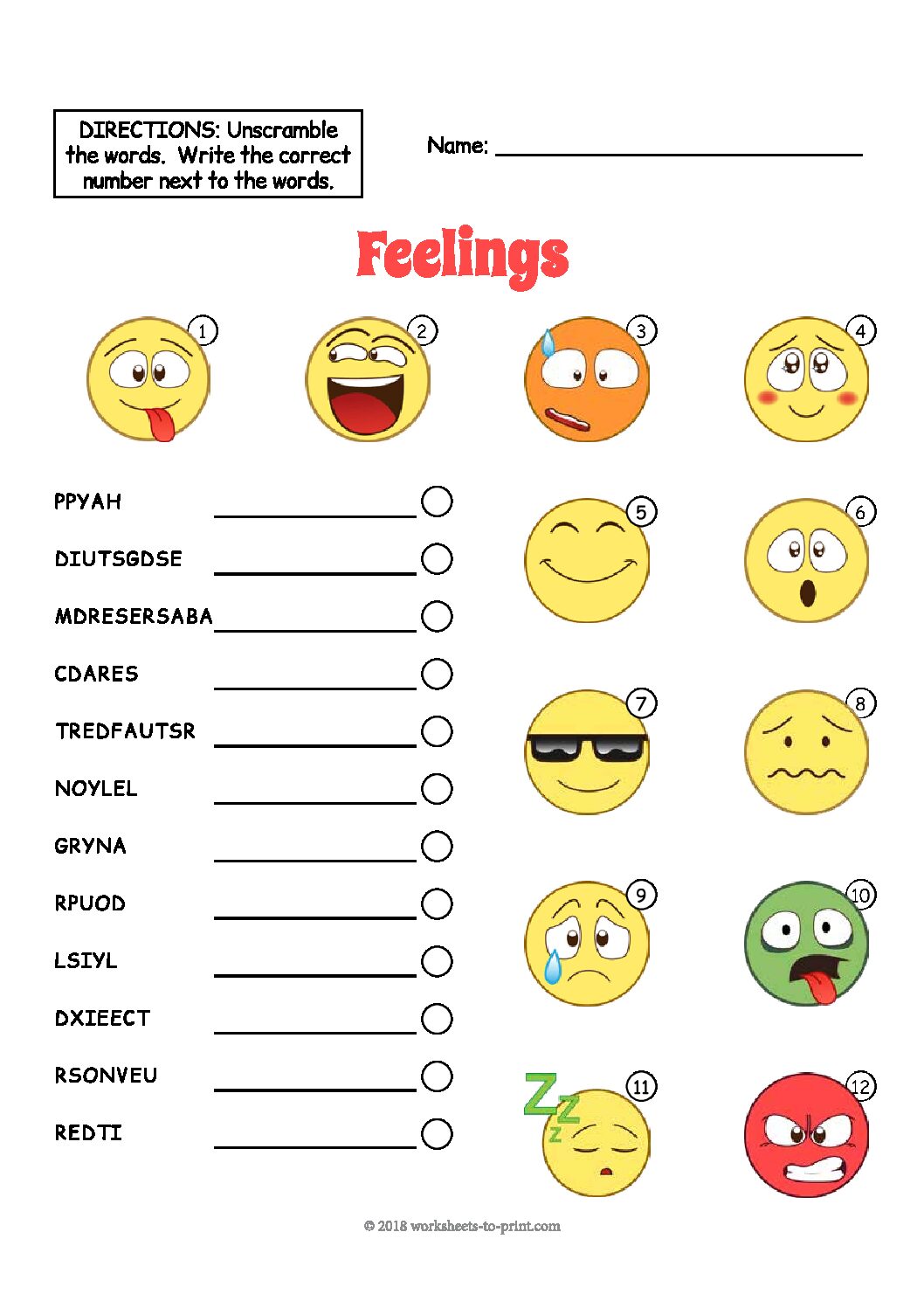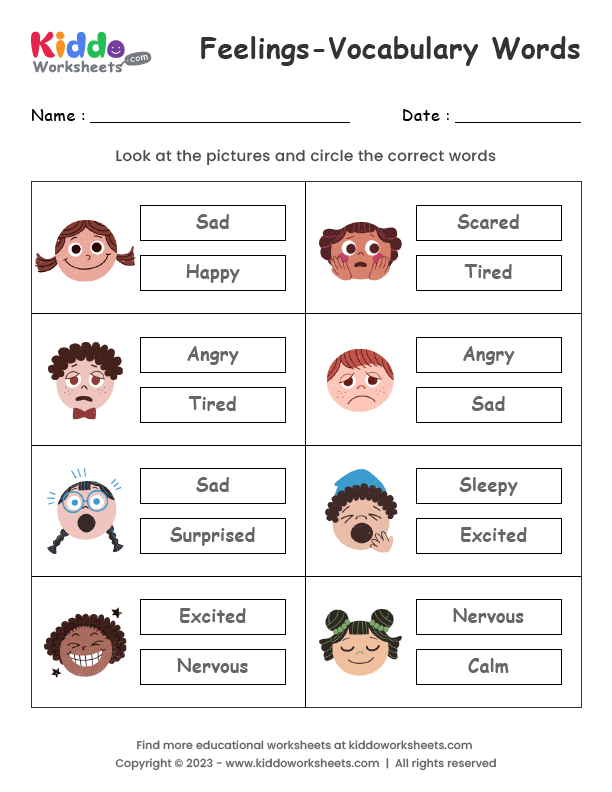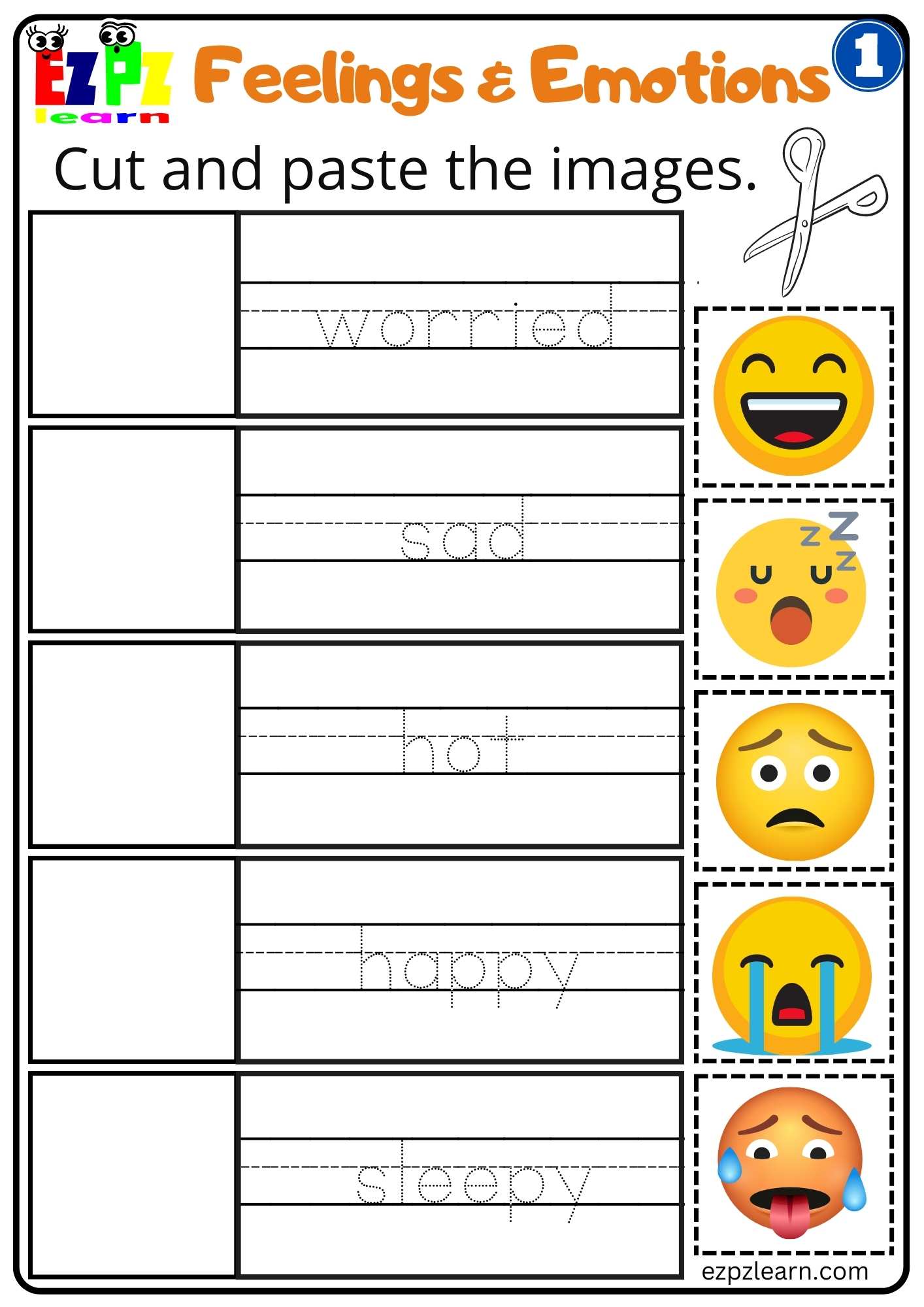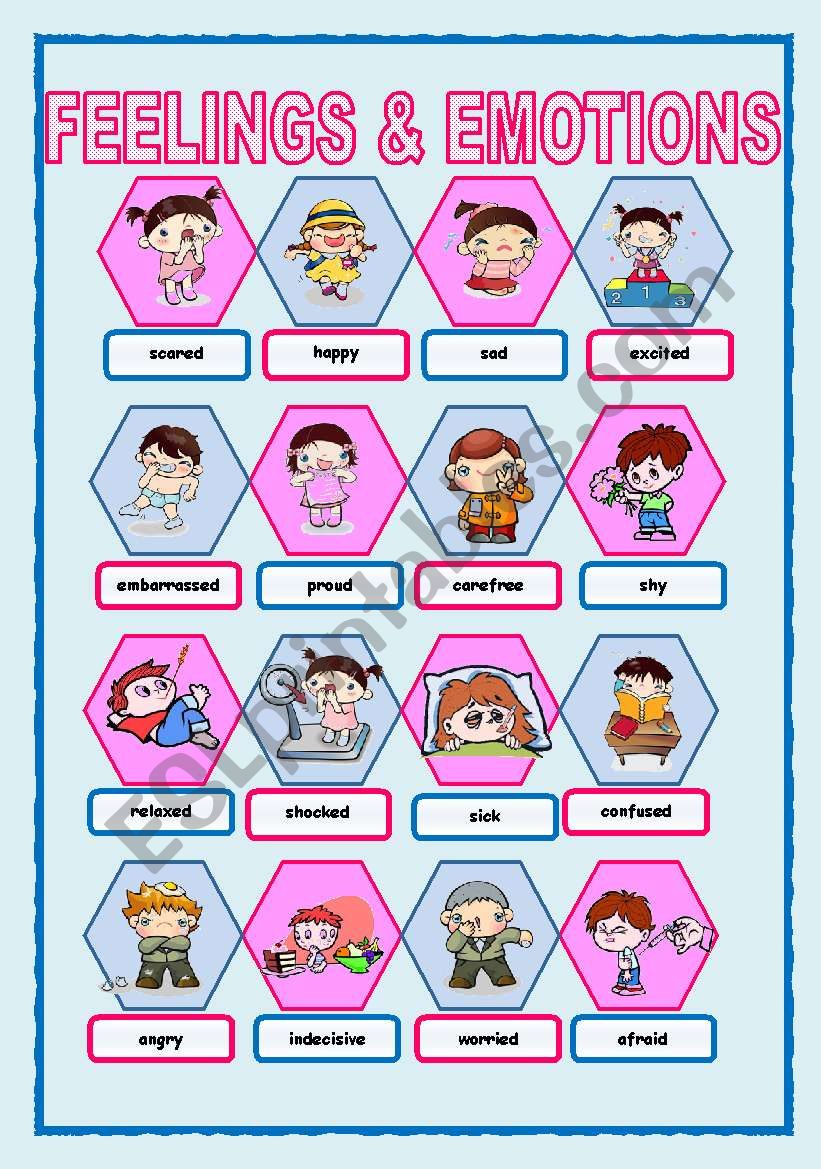
Unlocking Emotional Intelligence: The Transformative Power of Feelings Vocabulary Worksheets
In an increasingly complex world, the ability to understand, articulate, and manage one’s emotions is paramount to well-being, healthy relationships, and overall success. This crucial skill, often referred to as emotional literacy, doesn’t always come naturally. Many individuals, both children and adults, struggle to pinpoint exactly what they are feeling, leading to frustration, miscommunication, and internal turmoil. The solution often lies in building a robust emotional vocabulary, and one of the most effective tools for achieving this are feelings vocabulary worksheets. These versatile resources provide a structured, engaging, and accessible way for people of all ages to explore the vast spectrum of human emotions, moving beyond simplistic labels like "good" or "bad" to embrace a nuanced understanding of their inner world.
This article delves into the profound benefits, diverse types, and effective implementation of feelings vocabulary worksheets, highlighting their indispensable role in fostering emotional intelligence across various settings, from homes and classrooms to therapy rooms and professional development programs.

The Foundation: Why Emotional Literacy Matters

Before exploring the mechanics of feelings vocabulary worksheets, it’s essential to grasp the fundamental importance of emotional literacy. Emotional literacy is the capacity to identify, understand, express, and manage emotions in oneself and others. It encompasses:

- Self-Awareness: Recognizing one’s own feelings as they occur.
- Self-Regulation: Managing distressing emotions and impulses.
- Motivation: Using emotions to achieve goals.
- Empathy: Understanding and sharing the feelings of others.
- Social Skills: Handling emotions in relationships and accurately reading social cues.



Individuals with high emotional literacy tend to have stronger relationships, perform better academically and professionally, experience less stress, and possess greater resilience in the face of life’s challenges. Conversely, a limited emotional vocabulary can lead to:
- Communication Breakdown: Inability to clearly express needs or concerns.
- Misunderstanding: Interpreting others’ actions or words incorrectly due to emotional blind spots.
- Emotional Dysregulation: Difficulty managing intense feelings, leading to outbursts or withdrawal.
- Internalized Stress: Unexpressed emotions can manifest as physical symptoms or mental health issues.
- Lack of Empathy: Struggling to connect with or understand the experiences of others.



This is precisely where feelings vocabulary worksheets step in, providing the linguistic tools necessary to bridge these gaps and build a solid foundation for emotional well-being.
What Are Feelings Vocabulary Worksheets?
At their core, feelings vocabulary worksheets are educational tools designed to expand an individual’s lexicon of emotion words. They move beyond basic terms like "happy," "sad," and "angry" to introduce a richer, more descriptive array of feelings such as "frustrated," "anxious," "elated," "lonely," "content," "resentful," or "curious."
These worksheets are not just about memorizing words; they are about connecting those words to internal sensations, external cues, and real-life situations. They help individuals:
- Identify: Recognize and name their feelings.
- Differentiate: Distinguish between similar emotions (e.g., annoyance vs. rage, sadness vs. grief).
- Express: Communicate their emotional state clearly and appropriately.
- Understand Intensity: Grasp that emotions exist on a spectrum (e.g., slightly annoyed vs. furious).
- Explore Triggers: Begin to understand what causes certain feelings.
They are incredibly adaptable and can be tailored for various age groups and learning styles, making them a valuable asset in diverse educational and therapeutic contexts.
The Transformative Benefits of Using Feelings Vocabulary Worksheets
The consistent use of these specialized worksheets yields a multitude of profound benefits that ripple through various aspects of an individual’s life:
-
Enhanced Self-Awareness: By providing specific words for nuanced emotions, worksheets help individuals tune into their internal experiences. Instead of just feeling "bad," a child might learn they are "frustrated," "disappointed," or "overwhelmed." This precise labeling is the first step towards understanding why they feel a certain way and what they might need.
-
Improved Communication Skills: When individuals have the words to describe their feelings, they can communicate more effectively with others. This reduces misunderstandings, fosters empathy, and strengthens relationships. For example, a teenager who can say, "I feel overwhelmed by my homework load," is more likely to receive support than one who simply shouts, "I hate school!"
-
Better Emotional Regulation: The act of naming an emotion can, in itself, reduce its intensity. This is often referred to as "name it to tame it." Feelings vocabulary worksheets provide the practice needed to quickly identify emotions, which is crucial for then employing coping strategies. If you know you’re feeling "anxious," you can engage in deep breathing; if you’re "frustrated," you might take a break.
-
Increased Empathy and Social Connection: When one can articulate their own feelings, they become more attuned to the emotions of others. Understanding that someone else might be feeling "isolated" or "apprehensive" allows for a more compassionate and appropriate response, fostering deeper social bonds. Worksheets often include scenarios that encourage users to consider how others might feel, building crucial empathy skills.
-
Reduced Anxiety and Frustration: The inability to express oneself emotionally can be a significant source of anxiety and frustration. Worksheets provide a safe, structured environment to practice this expression, alleviating the pressure of finding the "right words" in a stressful real-time situation.
-
Academic and Professional Success: Emotional intelligence is increasingly recognized as a key predictor of success. Students who can manage their emotions are better learners, and adults who can navigate complex emotional landscapes are more effective leaders and team members. Feelings vocabulary worksheets contribute directly to developing this critical skill set.
-
Support for Mental Health: For individuals struggling with anxiety, depression, or other mental health challenges, identifying and expressing emotions is a vital part of therapy and recovery. These worksheets serve as foundational tools for therapists, helping clients articulate their internal states, which is essential for therapeutic progress.
Diverse Types of Feelings Vocabulary Worksheets
The beauty of feelings vocabulary worksheets lies in their versatility. They come in many forms, catering to different ages, learning styles, and objectives:
-
Matching Activities:
- Picture-to-Word: For younger children, matching images of facial expressions or body language to emotion words (e.g., a frowning face to "sad").
- Word-to-Definition: For older children and adults, matching emotion words to their precise definitions.
- Scenario-to-Emotion: Presenting short scenarios and asking users to choose the feeling best associated with it.
-
Intensity Scales (Emotion Thermometers/Gauges):
- These worksheets help users understand that emotions exist on a spectrum. They might list "annoyed," "frustrated," "angry," "furious" along a scale, asking the user to rank their current feeling or a feeling from a scenario.
-
Situational Application Worksheets:
- "How Would You Feel If…" prompts: Presenting various hypothetical situations and asking users to write or draw how they would feel and why.
- "Story Starters": Providing the beginning of a story and asking users to complete it, focusing on the characters’ emotional journeys.
-
Creative Expression Worksheets:
- Drawing Emotions: Encouraging users to draw what a specific emotion looks like or feels like to them.
- Emotion Word Clouds/Collages: Creating visual representations of emotional words and their connections.
- Journaling Prompts: Daily check-ins where users identify and elaborate on their feelings, using newly learned vocabulary.
-
Categorization and Nuance Worksheets:
- Synonym/Antonym Lists: Exploring words that are similar or opposite in meaning (e.g., "joyful," "elated," "ecstatic" vs. "gloomy," "melancholy").
- Emotion Families: Grouping emotions that share a common root or theme (e.g., "anger" family: irritation, frustration, rage).
-
ESL/EFL Specific Worksheets:
- Designed for language learners, these often combine vocabulary building with grammar practice, sentence construction, and cultural nuances of emotional expression.
Designing and Implementing Effective Feelings Vocabulary Worksheets
Simply handing out worksheets isn’t enough. For feelings vocabulary worksheets to be truly impactful, careful consideration must be given to their design and implementation:
-
Age-Appropriateness: Use language, visuals, and concepts that are suitable for the developmental stage of the user. Simple pictures for preschoolers, relatable scenarios for teens, and complex nuances for adults.
-
Variety is Key: Rotate different types of activities to maintain engagement and cater to diverse learning styles. Mix matching with writing, drawing with discussion.
-
Visual Appeal: Use clear fonts, engaging illustrations, and thoughtful layouts. A cluttered or visually unappealing worksheet can be demotivating.
-
Real-World Relevance: Connect emotion words to situations that the user can relate to in their daily lives. This makes the learning more meaningful and applicable.
-
Integrate with Discussion and Role-Play: Worksheets should not be solitary activities. Follow them up with open discussions, where users can share their responses, ask questions, and practice using the new vocabulary in conversation. Role-playing scenarios can further solidify understanding and application.
-
Consistency and Repetition: Learning an emotional vocabulary is an ongoing process. Regular, even short, engagements with these worksheets will yield better results than sporadic, intense sessions.
-
Positive Reinforcement: Encourage effort and progress, not just "correct" answers. Emotional expression is deeply personal, and the goal is exploration and understanding, not perfection.
-
Facilitator’s Role: Whether a parent, teacher, or therapist, the facilitator’s role is crucial. They should model emotional expression, create a safe and non-judgmental environment, and be prepared to answer questions and provide further examples.
Who Can Benefit from Feelings Vocabulary Worksheets?
The utility of these worksheets extends across a broad spectrum of individuals and professionals:
- Parents and Guardians: To help children identify and express their feelings, building a foundation for emotional health from a young age.
- Educators (Pre-K to High School): To integrate social-emotional learning (SEL) into the curriculum, improving classroom dynamics and academic outcomes.
- Therapists and Counselors: As a fundamental tool for clients of all ages to articulate their internal experiences, which is essential for therapeutic progress.
- ESL/EFL Instructors: To teach not just the words but also the cultural context and nuances of emotional expression in a new language.
- Human Resources and Corporate Trainers: To foster emotional intelligence in the workplace, leading to better team collaboration, conflict resolution, and leadership skills.
- Individuals Seeking Self-Improvement: For anyone looking to deepen their self-awareness and improve their emotional communication skills independently.
Conclusion
In a world increasingly recognizing the value of emotional intelligence, feelings vocabulary worksheets stand out as invaluable resources. They are far more than just lists of words; they are gateways to deeper self-understanding, clearer communication, stronger relationships, and enhanced well-being. By providing the linguistic scaffolding necessary to navigate the intricate landscape of human emotions, these worksheets empower individuals to articulate their inner world with precision and confidence. Investing in the development of emotional vocabulary through these practical tools is not just an educational endeavor; it is an investment in a more emotionally literate, empathetic, and resilient society. As we equip ourselves and future generations with the language of feelings, we unlock the potential for a richer, more connected human experience.
